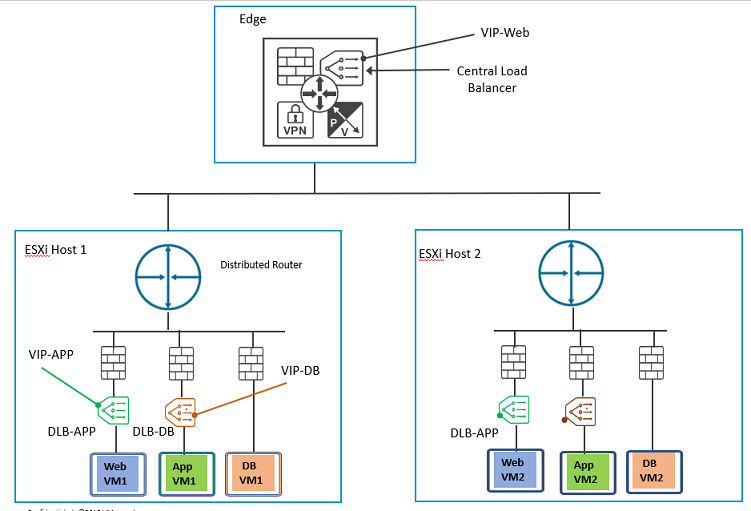A Distributed Load Balancer configured in NSX can help you effectively load balance East-West traffic and scale traffic because it runs on each ESXi host.
Important: Distributed Load Balancer is supported only for Kubernetes (K8s) cluster IPs managed by
vSphere with Kubernetes. Distributed Load Balancer is not supported for any other workload types. As an administrator, you cannot use
NSX Manager GUI to create or modify Distributed Load Balancer objects. These objects are pushed by
VMware vCenter through
NSX API when K8 cluster IPs are created in
VMware vCenter.
In traditional networks, a central load balancer deployed on an NSX Edge node is configured to distribute traffic load managed by virtual servers that are configured on the load balancer.
If you are using a central balancer, increasing the number of virtual servers in the load balancer pool might not always meet scale or performance criteria for a multi-tier distributed application. A distributed load balancer is realized on each hypervisor where load balancing workloads, such as clients and servers are deployed, ensuring traffic is load balanced on each hypervisor in a distributed way.
A distributed load balancer can be configured on the NSX network along with a central load balancer.

In the diagram, an instance of the Distributed Load Balancer is attached to a VM group. As the VMs are downlinks to the distributed logical router, Distributed Load Balancer only load balances east-west traffic. In contrast, the central load balancer, manages north-south traffic.
To cater load balancing requirements of each component or module of an application, a distributed load balancer can be attached to each tier of an application. For example, to serve a user request, a frontend of the application needs to reach out to the middle module to get data. However, the middle layer might not be deployed to serve the final data to the user, so it needs to reach out the backend layer to get additional data. For a complex application, many modules might need to interact with each other to get information. Along with complexity, when the number of user request increase exponentially, a distributed load balancer can efficiently meet the user needs without taking a performance hit. Configuring a Distributed Load Balancer on every host achieves issues of scale and packet transmission efficiency.
Important: Enable DFW for DLB workloads. Disabling DFW either globally or through the DFW Exclusion List will cause an outage on DLB workloads.
